#How To Grow Grape Plants From Seeds
Explore tagged Tumblr posts
Text
Trying to figure out TP Link's diet based on his environment.


Livestock-wise, we've got cuccos and goats. That means
Eggs
Milk
Butter
Cheese
Potentially meat, but I don't think they get eaten unless they're old. Too valuable otherwise | EDIT: Oh yeah you need to breed goats every couple years to get milk. Add in cabrito veal!
And we know for a fact that Ordon Goat Cheese specifically is a thing. Stamped wheel and everything.

There's also fish

And bees/hornets(? It's called bee larva, but the enemy is a Hylian Hornet)

Useful for bait, but Link can eat them.
Did some more research, and apparently in Japan they eat wasp larvae? Specifically in Kushihara. So I'm counting it.

Then plants-wise we have pumpkins

And...corn. Somehow. I've never seen corn growing, but Link has some hanging in his house, so it exists.

I'm choosing to believe it comes from these plants that grow in patches around Ordon.
That gives us a lot. We've got
Cornstarch
Cornmeal
Corn oil
Corn shoots
Pumpkin seeds
Pumpkin seed oil
Pumpkin flour
Pumpkin blossoms
No source of sugar, but depending on how the pumpkins in Ordon taste, they could be naturally sweet. Like pie pumpkins. Also corn syrup is a thing if it's a sweet corn. So corn syrup needs cream of tartar which comes from grapes and apples and such. It's a byproduct of wine. No corn syrup.
Edit: Malt sugar, though!
Now for hypothetical foods.

Ordon is surrounded by pine trees, so that adds pine needle tea and pine nuts to the mix. I was a little worried about species, but apparently there are a lot of pine trees that make edible seeds, so on the list it goes.



Then there are frogs near Rusl and Uli's house, wild songbirds on cliffs, and a squirrel that talks to Link directly, so those are huntable sources of meat.

Is horse grass a cattail? Maybe? Initially, I thought it was—the ends look like cattail seedpuffs, but the leaves are completely different.
I want to treat them like cattails. Cattails that also are probably the main food source for Epona and the goats.
If we do that, that means, on top of all the other uses cattails have like stuffing and tinder and antiseptic, we get
Roots
Shoots
Ground seeds
Can't find a good match for hawk grass though. Concluding that that's not edible. Equivalent exchange and all.
Side note, how do you think horse grass spreads? It's almost always in groups of two or more plants, so that suggests rhizomes, but the image of Link picking one up to blow and stuffing flying out the end of the horseshoe is hilarious to me.


Up next, there are ferns, primarily near trees. After very careful and way-too-deep analysis of a pixelated fern's leaves, I think it's bracken fern.
Which is mildly poisonous.
And also edible.
On the list it goes!

Then finally, Sera has some kind of herb hanging in her shop.
I don't know what it is. I'm calling it Ordon Spice. Congratulations, Ordon Pumpkin Spice is now a thing.
#long post#twilight princess#loz#zelda#analysis#theory#worldbuilding#hello it is bee being a nerd about zelda hours again
759 notes
·
View notes
Text
Ko-fi prompt from IndigoMay:
What would be the economic impact if people could magically grow whatever food they liked? Including fodder for animals.
This is a very wide-ranging question, like... when was the magic introduced? What was the state of agriculture before that? Is this food generated from existing matter, delivered by gods, or something else?
I'm going to narrow this to:
What would happen if people could, starting tomorrow, grow any plant...
That is edible, by either humans or livestock, with appropriate treatment.
Without delay, meaning that the time sink is several minutes instead of weeks or months.
Without concerns for weather or other natural dangers like fungal infections or pests, or requirements for water or fertilizer.
Without depleting soil nutrients, so long as they have arable land to work with.
Without relying on fresh seeds or other 'raw ingredients' like leaf cuttings.
Well... let's start small.
Personal Basis - people who are not farmers
People who do not normally grow things would start angling to acquire some kind basic gardening implements. For some, like those who live in the suburbs, this would be as simple as going into the backyard. For those in cities, they'd need to get a window box or similar to use. If you have free, guaranteed fresh plant matter, that's already a good thing, but the time and care required to keep a garden alive is more than some people can manage due to work or children or housing. With immediate food that requires minimal effort, a lot of those hurdles are removed. You can grow the two tomatoes you need for dinner, and then put the pot of soil away for tomorrow.
The cost of
Personal Basis - small farmers
The obvious impacts for those who are small farmers is that people are less likely to buy their raw ingredients. Most of these small farmers would start looking into modifying their operations to do things that require processing.
Growing apples in your house for a snack is fine--if you have a pot big enough for a small tree, and a way to dispose of the wood if it's a one-time thing--but if you want applesauce or cider or pie, someone who knows how to cook or bake needs to do that part. You can grow wheat, but your chances of having the necessary tools to grind flour are slim. You can grow cashews, but fuck knows how you're going to process that without poisoning yourself! You can grow grapes on your trellis, but that doesn't mean you have the knowledge to make wine without accidentally going straight to vinegar. You can grow corn, but that doesn't mean you know the best way to dry it to make popcorn.
So small farms shift to those products that either need processing, or are part of an animal-based food. This includes things like flowers for bees. You can't really control bees, so just 'grow and go' might incite the bees to leave somehow. Maybe they can sense magic! Who knows!
Another option would be to focus on unique or heirloom things. If you go to a farmer's market, you might be going just to see all the fruits you've never encountered before. If there's an apple stand one year, and suddenly you can grow your own apples at home, then maybe what they start doing is growing unique or rare cultivars that you've never heard of, and that's their new niche. It's not that you can't grow the apples, but would you grow them if you've never heard of them? Plus, the apple stand is doing sauces and ciders now.
Mid-tier and large farms
These farms will start to focus in on large-scale crops that don't go straight to tables or cooking pots in homes. Scrap the eggplants, the cucumbers, the blueberries. Focus on:
Fruits and vegetables that are needed for popular secondary products, like tomatoes (ketchup, marinara), or oranges (juice), or corn (anything with fructose corn syrups, popcorn).
Plants that are popular but NEED processing to be edible, like coffee beans, cocoa beans, or wheat, that most people just don't have.
Plants that are needed in massive quantities for animal feed, such as alfalfa or chicken grains.
Now, I think these large farms would still be in production. We'd see a massive reduction in water usage, which is great (except for cranberries, I guess), but many of these products would still be needed in quantities that need industrial levels of processing. Someone needs to pick the oranges, to drive them to the juicing facility, the facility needs to juice and treat and preserve and bottle them, and then that needs to be driven to the store. The reduced time to grow, reduced water usage, reduced waste from natural predators or dangers, and general ability to plan things more efficiently would result in lower costs for many of these products in a truly free market... but would possibly also rise in cost as companies try to maintain a consistent flow of profit.
Sure you can make the juice at home, but what if you're already at work? There's still a demand for products; most of us can get water from a tap at home, but there are still convenience stores selling bottled water on every other corner in a big city.
I think the most interesting of these concerns would be grazing animals, like sheep, cattle, and goats. Being able to 'refresh' the grass of a single field without having to rotate the animals to new pastures once they've eaten away at one, and without damaging the nutrient profiles of the one they're staying at, means reduced deforestation or soil destabilization in agricultural areas. We'd see a fairly significant stalling of things like the decimation of Mongolia's grasslands if the goats didn't need as much grazing land.
Maintaining the meat industry would be one of the most constant sources of demand for large-scale agriculture, given that other products could go through cycles to more efficiently use land. You can grow and harvest oranges for Tropicana on Monday, grapes for Welch's on Tuesday, soy beans for Silk on Wednesday, tomatoes for Heinz on Thursday, and so on. They probably won't need more than they used to.
Meanwhile, the cows gotta eat. And eat. And eat.
Corporations
This one is fun! MONSANTO'S GONNA BE PISSED.
So, magically growing food, you don't need seeds, at least in this case. Or you can coax more product out of a seed you already have planted. You've gotten eight cycles corn out of this one stalk this season!
So Monsanto loses some of that insane seed monopoly situation.
You'd see a decrease in pesticides and anti-fungal products as agriculture speeds up a cycle by enough to prevent the spread of dangerous infestations. It's not going to kill your entire farm if you find fungus one day and have to burn it to prevent the spread. You lost one day's profit, not a full year's.
This impacts Monsanto too. Remember the Roundup debacle?
Now, to be clear, there are still plants that will rely on pesticides and anti-fungals. The premise only covers food, after all, so there are still important plants that will need longer, dedicated growing seasons.
Industry-wide shifts
Sooooooooooo a lot of the money starts to come from non-edible plants. This is your cottons, linens, hemps, latex/rubber trees, cork trees, lumber, and so on.
As the needed arable land necessary to feed humanity (and our livestock) decreases, more land is freed up for return to indigenous peoples, reclamation by nature, usage for alternate cultivation, housing, or... well, other capitalist ventures, like bitcoin mining or whatever.
On a geopolitical level, this causes some interesting shifts in places that draw their power from being 'breadbasket' nations. For instance, if you remember the start of the Russo-Ukrainian war, we saw some major pressures being placed by virtue of some countries (e.g. Lebanon, Pakistan) getting most of their wheat from Ukraine, and the war suddenly cutting off a massive portion of how they fed their people. Much of Ukraine's support, in those early days, derived from their importance as a breadbasket nation. If everyone can grown their own food, that moves the lines. Countries that are poor on space or water can stop relying on trade to survive in terms of water. Countries that rely on their agriculture to be able to trade for other things need to diversify their economies, and fast.
(Does mean that Saudi Arabia can stop using Arizona's water, though.)
The greatest shifts would come down to water usage and pollution, I think. Agriculture is currently one of the biggest contributors to the climate crisis, and the reduction of water use by farming would be a massive help. However, I'm less sure of how we'd see meat consumption change. The greater availability of fresh fruits and vegetables could result in a shift towards more plant-based diets worldwide, but just as easily we could see large agricultural corporations (and those that rely on them, like John Deere or the aforementioned Monsanto) market meat to consumers as a greater rate due to the profit margin.
Oh, also, I have a feeling that a lot of those corporations would try to get garden centers shut down, or buy out ceramic pot and planter factories. If you can't grow anything at home because you don't have a window planter, you have to buy from the store, right?
#ko fi#ko-fi#ko fi prompts#phoenix talks#magic#agriculture#microeconomics#macroeconomics#politics#environmentalism#water usage#pollution
109 notes
·
View notes
Text
Dionysus Offerings/Devotional Acts
There'll be NSFW themes as he is the god of wine and ecstasy!
Offerings
Wine/Intoxication
Alcohol, specifically wine
Grapes
Wine corks
Wine glasses
Shot glasses
Goblets
Corkscrews
Sparkling cider
Grape flavored things
Cheese
Weed/hallucenigens
Nips (small alcohol bottles)
Bottle opener
Beer/soda tabs
Alcohol bottles with cool labels
Fruit/fruit seeds
Theater/Plays
Play/theater scripts
Play/movie tickets
Masks
Costumes
Nature
Pine cones
Fennel
Wildflowers
Fig/fig newtons
Ivy
Leopard/cheetah print
Honey
Bull imagery
Donkey imagery
Bones
Antlers
Dead/preserved animals
Hiking gear
Seeds
Dolphins
Depictions of big cats
Wheat
Barley
Ecstasy
Concert/festival tickets
Various drugs (use safely!)
Sex toys
Your favorite music
Misc.
Locks of hair
Shaven beard hair
Pride swag
Extravagant clothes/clothes that make you feel good
Devotional Acts
Wine/Intoxication
Drink alcohol/get drunk
Go to a wine tasting
Make wine
Eat grapes
Trip intentionally/spiritually
Learn about substance abuse/recovery
Destigamtize drug users
Learn about harm reduction
Use drugs safely
Theater
Attend a play
Write a play/film/musical
Make home videos
Write poetry
Act
Dress up
Go to the movie theater
Nature
Go to the woods
Dance/sing in the woods
Meditate in the woods
Learn wilderness safety and first aid
Learn what to do when encountering a wild animal
Go off the beaten path
Explore new areas
Pick up litter
Forage
Recycle bottles
Grow fruit
Try new fruits
Ecstasy
Attend concerts/festivals
Attend/throw parties/celebrations
Have sex
Masturbate
Have threesomes/swing/whatever you’re in to
Finally give into that one kink you’ve been repressing (you know the one)
Do drugs (responsibly)
Learn about consent/establish boundaries with partners
Death/Rebirth
Dionysus is a god of rebirth and resurrection. This association comes from his birth stories and has resulted in epithets like “twice-born.”
Learn how to preserve dead animals
Learn about different life cycles (plants, animals, etc)
Learn about your ancestry
Foreigners
Dionysus is also seen as a foreign god with unknown origins. He also traveled through and invaded India.
Learn about immigration in your area
Learn about different cultures
Try foreign foods
Learn a new language
Learn about your ancestry
Help immigrants in your area
Misc.
Grow your hair out
Manifest/Keep a manifestation journal. Sexual/creative energy is linked and can be used to manifest
Shed your old self
Self-reflection/self-exploration
Identify areas where you may overindulge (food, substances, spending, etc.)
#dionysus worship#dionysus#helpol#greek gods#paganism#hellenic polytheism#bacchus#witchblr#dionysus offerings#offerings#wine
404 notes
·
View notes
Note
Hi!
Can you rank the sve bachelors and bachelorettes (maybe some other characters too) on how they well they adapt to farming? Similar to what you posted about sdv characters.
Have a good day!
Sure thing, dear anon 😊 Thanks for the ask and have a good day too!
_________________________________________
Sophia gets a 9/10 without a doubt. She's a farmer too, after all, and even though pretty much the only crop she's grown is grapes, she won't have any problems with other crops. The only reason I didn't give the pink-haired girl the maximum score is that I think she'll have a bit of trouble taking care of the animals in the chicken coop and barn at first. But she'll get used to it quickly, farm life isn't new to her.
Scarlett gets a well-deserved 8/10. The girl is not afraid of hard work in the field, she comes every season to learn farming from her friend Sophia, Andy and Susan, and dreams of her own little land, where she will also grow her own cherries and take care of the goats. Scarlett already has the experience, and the ambition to improve is considerable. So the girl will fit in perfectly.
5/10 for Olivia. At first it may seem that she is not adapted to working with plants, but behind her house, however, there are healthy and beautiful flowers. The former Joja accountant isn't afraid of dirt, she just needs to put on the right clothes and gloves and she's ready to go. Olivia doesn't have the experience to take care of a huge field of melons, but she can take care of flowers, such as a small number of roses or blue jazz, and she has plenty of time.
Claire was too tired from her soul-sucking job at JojaMart to devote herself to several hobbies at once. So her priority was books or, literally, just sleeping. And there was no time to take care of at least a few crops near her home. Though she knows a few lifehacks about growing tea leaves, but that's about it. 3/10.
As for Lance... The gallant adventurer gets a 6/10. Although he honestly admits that he knows nothing about farming, and his experience has been exclusively with monster crops, he has a trick in his sleeve - magic. You could say he has a kind of cheat code where Lance can still become useful on the farm, even without much skill. There are pros and cons to it, tho. 6/10.
Magnus gets his 8.5/10. Taking care of plants is not only his hobby, but also a way to get fruits and vegetables for dinner, experiments, and elixirs. Plus, the wizard doesn't have to go to Pierre's to buy seeds... And with magic, he does a great job of protecting his flowers and fruit from voracious insects (and his ex-wife). And if he's lucky, he'll share the farming secrets he's managed to learn over his lifetime. A very good result.
I don't remember any mention where Victor talked about his responsibilities to take care of the flowers at the back of his house (except to complain about house chores when he doesn't have time). He's generally a very hard-working young man, but his passion is bridges, so he devoted almost all of his time to that. Plants will be difficult for him at first, that's for sure. 2/10.
#stardew valley expanded#sve#sve olivia#sve sophia#sve scarlett#sve claire#sve lance#sve victor#sve magnus#sdv wizard#sve headcanons#thanks for the ask!#a reminder - this is just my opinion#if you have different thoughts - feel free to comment here. i would like to read this 💕
25 notes
·
View notes
Text
Demeter Cabin headcanons 🌾
---------------🌼🌼🌼🌼🌼🌼---------------
❃ The Demeter cabin are best friends with the dryads
❃ they constantly visit the Athena cabin because they have books about plants and agriculture in their bookshelves
❃ the Demeter cabin lends a certain amount of plants/herbs to the Hecate cabin every few weeks, the Hecate cabin in turn make a few stuff to help the Demeter cabin grow plants quicker
❃ they hug trees.
❃ they climb trees with the Hermes kids and hang out with them
❃ they brought coffee to camp half blood by somehow creating a mini coffee plantation. everyone literally loves them for it.
❃ the aphrodite cabin ask the Demeter cabin for flowers that they can braid in hair
❃ they have an unending supply of snacks because like a quarter of their plants are edible
❃ you know how we have pen stands? the Demeter cabin have seed stands. everywhere.
❃ they like to annoy Nico and their excuse is that "his father kidnapped their cousin" but they all collectively agree that persephone is better off as the queen of the underworld
❃ the force the Hephaestus cabin to build flower crowns for them. they've given in.
❃ they like to give everyone on camp a certain plant or tree associated with them as a joke.
❃ the Apollo kids come to the demeter cabin for help with medicine.
❃ they all have stories of trying to hug a cactus or a poisonous plant from their childhood.
❃ speaking of cacti, their form of taking revenge is asking the Hermes cabin to put a line of cacti next to someone's bed so that when that someone wakes up they step on a cactus first thing in the morning. but this is only reserved for people who have done something HORRIBLE, because the Demeter cabin is usually chill
❃ they grow grapes so that they can get on the good side of Mr. D
#Demeter#cabin 4#demeter cabin headcanons#they are definitely tree huggers tho#like no matter how big a tree is they hug it#plants#percy Jackson#riordanverse#riordanverse headcanons#percy jackson headcanon#heroes of Olympus#pjo headcanon#pjo hoo toa#demigods#camp half blood
56 notes
·
View notes
Text
The (Real) Stardew Valley Farm Update 2024
I’m wrapping up my third year trying to grow everything from Stardew Valley in our yard, with substitutions as needed, preferably with Midwest USA native plants.
I’m continuing to battle the invasive plants (why won’t the honeysuckle and thistles stop?????), beg for truckloads of woodchips (Google decided our address isn’t real anymore), and deal with a body and brain that makes going outside impossible sometimes (the past two years have been rough medically). But despite all of that I still managed to make a ton of progress!
Here’s how things stand as of now. If you’re looking back at previous posts you might notice some differences, but that’s mainly because things I planted died (drought + medical crises don’t bode well for newly established plants). I’ve also added the additional crops from the new update.
2021
Amaranth - Native white amaranth
Grape - Native riverbank grapes (so many grapes). I’m hopefully going to successfully propagate some cuttings from the neighbor’s green cultivated variety
Dandelion - Obviously
Maple Tree - Native silver, red, and sugar maples
Pine Tree - Douglas fir
Apple Tree - Three old apple trees of different varieties in very rough shape. I’ve been working to prune them up and two are looking a lot better. I’d love an Enterprise apple tree at some point
Coffee Bean - Chicory (a naturalized plant commonly used as a coffee substitute)
Salmonberry - Native black raspberries since salmonberries aren’t from around here, although I really want to add raspberries of various colors in the future
Starfruit - Native wood sorrel
Cave Carrot - Queen Ann’s Lace, AKA wild carrot
2022
Kale
Rhubarb
Strawberry - Both cultivated and native
Tulip
Radish
Tomato
Eggplant
Fairy Rose - Native prairie rose
Cranberries - Native cranberry viburnum
Orange Tree -Native persimmons, which produce orange fruit
Daffodil
Spring Onion - Native nodding onions
Spice Berry - Native spicebushes
Wild Plum - Native plums
Crocus
Cherry Tree - Native black cherries and nonnative bush cherries
Banana Tree - Native pawpaws, which are also known as Indiana bananas
Sweet Gem Berry - Native Juneberry (Downy Serviceberry)
2023
Garlic - Native wild garlic
Blueberries - I planted three varieties and only one survived. Don’t shortcut your bed preparation, friends
Wild Horseradish - Not wild, but contained with my mint
Hops - Teamaker hops which is good for tea since we’re not alcohol fans
2024
Blue Jazz - Native Ozark Bluestar
Beets
Apricot Tree - Native passionflower vine, also known as wild apricot
Sunflower - Both native and non-native sunflowers
Pumpkin
Cactus Fruit - Native prickly pear cactus
Melon - Cantaloupe
Oak Tree - Native dwarf chinquapin oak, which took me forever to get
Hot Pepper
Palm Tree/coconut - Native palm sedge
Poppy - Native purple poppy mallow, after other native poppies failed. I still want to grow bread seed poppies, though
Corn - Tried some gorgeous colored corn and popcorn that didn’t grow great but they did grow!
Green bean
Hazelnut - They’re supposed to be easy to grow but they do not like me. Third time’s the charm, right?
Carrot
Summer squash
Powder melon - I decided to do honeydew melon because it’s kinda powdery and I don’t really have any other ideas
Planned for 2025 and beyond
Potato
Pineapple - White strawberries (pineberries)
Winter Root - Hopniss, a native root vegetable
Red Cabbage
Artichoke - Native Jerusalem artichokes
Yam
Bok Choy
Leek
Fiddlehead Fern - Ferns do not like me
Blackberry
Crystal Fruit - Probably honey berries, which produce fruit earlier than anything else
Ancient Fruit - Native Aronia berries. They’re blue(ish) and have lots of antioxidants so you live to be ancient
Tea Leaves - Native New Jersey Tea bush. The previous ones were murdered by rabbits
Mango Tree - I thought one of our pawpaws was a variety called mango but I was wrong
Ginger - I want to try growing native wild ginger again
Rice - Native rough-leaved rice grass
Wheat - I have some gorgeous ornamental blue wheat seeds
Summer Spangle - Possibly native prairie lily? I was unsuccessful growing it from seed this year but maybe in the future
Parsnip - I can’t get them to germinate to save my life but one day I will be successful
Sweat pea
Holly - Native winterberry holly
Mushrooms - I'm just gonna ignore varieties and try some plugs or similar
Peach - Vine peach. It’s a melon, and more doable than a tree
Mahogany Tree - I think I’ll resort to mahogany nasturtiums
Broccoli
Pomegranate Tree - I could try Russian pomegranates?
Taro Root - I would have to plant it in pots
Snow Yam - Not actually a yam but maybe native sweet potato vine?
Qi Fruit - Very creepy, not sure what to do with this
Over halfway there! If anyone has suggestions for plants please let me know because I’m still stuck on a few and very open to alternatives.
In other news, I’m making Stardew Valley Fair displays with cross stitch patches for each of the items I’ve added that year. I’ll have to post pics of those at some point.
#the (real) stardew valley farm#the habitat ring#gardening#stardew valley#don’t be a petaq grow native plants#I am making the best life decisions and this is definitely worth it
22 notes
·
View notes
Text
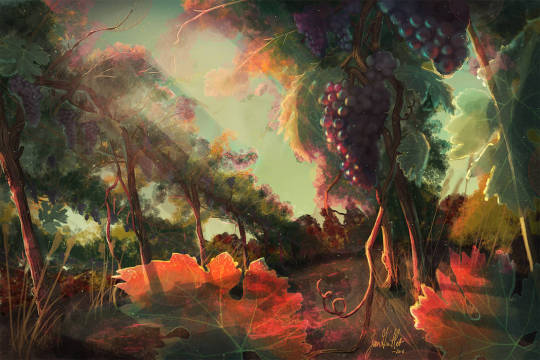
Deity: Litirenn, He who Guides the Vine
Days of bread and wine, are only by design/ Every petal worked, every spirit corked, every silver shined/ Every furnace lit, every lamb and spit, every silver shined/ -Only by Design, From Devil's Carnival: Alleluia!
It is hard work averting famine, a toil through seasons of gruelling weather to ensure the next harvest fares a little better than the last. To turn a scattering of seeds from errant prairie grasses into life sustaining bread is a generations long labour, but it is holy and there is no god that holds it more holy than Litirenn, Steward of Tilled Earth.
Born from a union between a god of growing things and a god of craft, Litirenn's sphere of influence has expanded over time from simple cultivation to any who wish to understand and then improve on nature's designs: Herbalists, natural philosophers, alchemists, biomancers, and those that would remake themselves seeking an inner truth.
Few temples are kept for him, but one can often find the Steward's marks worked in over the doorways of granaries, mills, and wine cellars, or sketched in the margins of a hand bound folio of research notes.
Adventure Hooks:
The grain harvest is coming in, which means the local brigands will be circling like buzzards and the village needs the party to act as bodyguards to ensure their livelihood seven samurai style. The brigands in question however are not outlaws but soldiers of the local warlord, who is currently in dispute with the village over how much grain they owe him for protection.
The village witch is in quite a fix after cultivating a new verity of foreign flower looking to make inadvertently attracting all sorts of weird magical insects to his cottage. The infestation has deprived him of his house, the town of herbal remedies, and the party of cheap healing potions. Something must be done about it.
Seeking to catalogue, preserve, and most of all taste every variety of apple ever grown on the material plane, an eccentric gnomish orchardist has broken into the elfqueen's private gardens and stolen a fruit from a silver tree placed there by the Archheart themselves. The queen's agents would like this handled delicately, not only because the gnome managed her infiltration by seducing the queen (who's quite broken up about it) but also disruption of the tree may juuuuuust have triggered a calamitous prophecy.
Signs: Plants fruiting out of season with abundant growth and fantastical properties, visions of how things came to be made. The appearance of frogs, butterflies, and other creatures that go through a metamorphosis.
Symbols: A vine laden trellis, though alchemical aspects often use the symbol of a snake coiled among grapes.
Titles: Steward of Tilled Earth, He who Guides the Vine, The Cultivator,
#deity#divinity: nature#divinity: harvest#seeking healing#bandits#thief#alchemist#Litirenn#dnd#dungeons and dragons#d&d#ttprg#pathfinder
156 notes
·
View notes
Note
Hi and I hope you are well! I don’t know if this is a weird question, but I’m always fascinated by the legends of the Reach particularly regarding the children of Garth Greenhand, and how that connects to the Faith in those areas. I think I saw a post you wrote some time ago about how for example Rowan Gold Tree’s story might have been adapted by the Faith into a parable about the Mother (apologies if I’m mistaken). I guess my question is, do you think Rowan and the others might have been actually worshipped as gods before the Faith, like Garth might have been? Also if I may ask a second question: do you have thoughts about Floris (my personal fave) how her story fits into Westeros’ patriarchal attitudes towards women? Does the fact that she founded three houses mean that she’s not vilified by the Faith for being non monogamous? Thanks and sorry again for weird questions!!
(I was mistaken, I think it was actually about Rowan’s story as a parable about the Maiden, like that her hair turned into a tree as a sign of being favored by the Maiden? I don’t quite remember who wrote this post.)
I have a vague memory of a post I wrote along similar lines a very long time ago too, but I couldn’t find it, so either I never did or I deleted it. Anyway, I do very much like to headcanon that the myth of Rowan Gold-Tree was co-opted by the Faith during its early establishment in the Reach as a myth about the Maiden - that Rowan, abandoned by her love for a richer rival, prayed to the Maiden in her heartbreak, and the Maiden, guardian and benefactor of virtuous maids, gave Rowan her golden tree, almost Cinderella style, perhaps as a sort of dowry to show that maidenly virtue was literally worth more than gold.
Whatever the particular relationship between the Faith and the myth of Rowan Gold-Tree, do I think that some or all of the legendary children of Garth Greenhand may have been worshiped as gods themselves? Very possibly. We know that there was at least some tradition of Garth being worshiped as or at least considered a god by Westerosi: Yandel notes that “[s]ome even say [Garth Greenhand] was a god” and that “[a] few of the very oldest tales” present Garth as a “considerably darker deity, one who demanded blood sacrifice from his worshippers to ensure a bountiful harvest” and a “green god [who] die[d] every autumn … only to be reborn with the coming of spring”. Yandel also compares Garth to fertility gods and goddesses worshiped by “[m]any of the more primitive peoples of the earth”, as Garth not only “taught men to farm” and “showed them how to plant and sow, how to raise crops and reap the harvest” but also scattered a seemingly divinely plentiful bag of various seeds and “brought the gift of fertility” to people and crops alike. Nor was this early history of Westeros an era without the worship of local deities beyond the old gods: the myth of Durran Godsgrief features a sea god and a goddess of the wind, the people of the Three Sisters worshiped the Lady of the Waved and the Lord of the Skies, and of course the ironborn believe in the eternal divine struggle between the Drowned God and the Storm God.
So I could see where, depending on the era and the location, various individuals among Garth’s legendary children might have been worshiped as gods or semi-divine heroes themselves. If Garth Greenhand was worshiped as a god for teaching the First Men to sow, cultivate, and reap, might Gilbert of the Vines have been similarly worshiped by the people of the Arbor for teaching these people “to make sweet wine” from their island’s lush native grapes (and indeed, might there have been some local tradition that Gilbert had inherited his father’s fertility and made these grapes grow “so fat and lush across their island”)? If Garth was treated as a god for his apparently mystical and/or divine ability to bring and cultivate life from the land, might Ellyn Ever-Sweet, Rowan Gold-Tree, and/or Rose of Red Lake have been similarly worshiped by the locals of Beesbury, Goldengrove, and/or Red Lake, respectively, for their supernatural, perhaps also seemingly divine, connections to and power over the natural world? If the earliest worshipers of Garth Greenhand offered him blood sacrifices in return for bountiful harvests, might worshipers have given Bors the Breaker similar blood sacrifices in return for grants of strength and courage, since he himself had supposedly drunk the blood of bulls to gain the power of 20 men? If Garth’s divine power included the gift of specifically sexual fertility so strong that he “[made] barren women fruitful with a touch” and caused “[m]aidens [to ripen] in his presence”, “mothers [to bring] forth twins or even triplets when he blessed them”, and “young girls [to flower] at his smile”, then might Harlon and Herndon have been similarly worshiped for the seeming eternal fertility they apparently enjoyed and represented as husbands to their woods witch wife, or Foss the Archer worshiped as a similar roving fertility god casting a welcome eye on maidens as his father had done (with his arrow and apple exploits perhaps a sort of sexual euphemism)? Again, these are just a few creative examples, but the larger point is that I could very well see where Garth’s children may have been seen not only as extensions of his own legend, but gods in their own right who took over aspects of the worship of Garth Greenhand. (To say nothing of whether any of them might have been worshiped for their own persons and/or deeds - if, say, John the Oak, Owen Oakenshield, and/or Brandon of the Bloody Blade might have been viewed as a sort of proto-Warrior or god of war, or if Maris the Maid became a sort of mother goddess for Oldtown and House Hightower.)
As far as Florys the Fox goes … eh. I think that strict monogamy was not an entirely consistent or mandated practiced among the First Men before the arrival of the Andals, including in the Reach: not only do the myths of both Florys and the twin ancestors of House Tarly feature as their protagonists participants in polygamous (and, indeed, polyandrous) marriages, but King Garland II successfully brought Oldtown into the Gardener kingdom by putting aside his wives, plural, to marry Lymond Hightower’s daughter. Nor indeed should we ignore the fact that Florys seems to have been considered clever not just for having three husbands but for keeping each a secret from the others - a suggestion, perhaps, that the expected (read: patriarchal) order of the universe, playfully subverted by the literally extraordinary Florys, was that a woman should be the submissive partner to a single man, rather than the dominant mistress keeping three men at her nuptial leisure. So I think the pre-Andal Reach may have accepted two beliefs as true at the same time - namely, a patriarchal world in which women were expected to serve and obey men and also a pro-polygamy world in which a demigod/heroine/goddess figure could be lauded for having kept multiple husbands simultaneously without being caught.
Too, I think it’s possible that just as septons and maesters downplayed the mythology and divinity of Garth Greenhand in later accounts - with Yandel noting that legends of Garth Greenhand, “though cherished by the smallfolk, are largely discounted by both the maesters of the Citadel and the septons of the Faith, who share the view that Garth Greenhand was a man, not a god” - so these same post-Andal Invasion academics may have deemphasized the myths surrounding Florys the Fox, including her celebrated polyandry. Perhaps dynastically persnickety maesters or septons argued that Florys had not really been married to three men, but rather that the myths had conflated her marriage to the ancestor of House Ball/Peake/Florent with marriages by other women, or perhaps remarriages by Florys, to the ancestors of the other two Houses. Perhaps the myth was bowdlerized to have Florys merely be courted by the founders of each of these Houses, rather than having her marrying each, with Florys perhaps then serving as more of a spiritual or romantic ancestress rather than a literal matriarch of this bloodline. Of course, it’s also possible that septons did look down on and preach against Florys for her polygamous marriages, branding her a “wanton” - though to what extent they could or would do so, while also looking to convert these powerful aristocratic families of the Reach, is speculative at best.
42 notes
·
View notes
Note
How long did ur grapes take to grow been wanting to do em from seed
my family insist the vine is over 20 years old but i’m pretty sure it was planted around 2017, loll!!
it’s had grapes every year since 2020 at least but animals (foxes, squirrels, birds, deer) usually get to them before us. there’s another grapevine that’s just as old but is like. 1/8th the size of that plant, so it’s luck of the draw i guess 🤷♀️
#from seed it would be a while HOWEVER#if it’s an ideal location they grow like weeds#down in my area mustang grapes grow incredibly fast starting in the spring and put out fruit by mid july#you could experiment with a native grape and see what works for you?#talk#ask
38 notes
·
View notes
Text
My Garden Flowers Part 2
All photos mine. The narrow-leaved sundrops photo is edited for colour since the camera apparently can't reproduce that intense of a yellow. Neither can any Photopea editing, but at least it's closer. It's the bright of highlighter yellow but more golden.























In order of appearance:
031. Philadelphia fleabane (Erigeron philadelphicus) A welcome "weed" I couldn't find available at any of the native plant places in Ontario (one in Manitoba carried it but it wasn't available) but she planted herself.
032. Canadian Lettuce (Lactuca canadensis) Another welcome "weed" that sadly didn't manage to reseed, but maybe one will turn up again.
033-034. Jack-in-the-Pulpit male and female flowers (Arisaema triphyllum) The male has one leaf set while the female has two. The babies only have a leafset and no flowers for the first couple years of their lives. Then they reach sexual maturity as males, the next year they'll be female and switch back and forth until the end of their lives.
035. Early Meadow Rue (Thalictrum dioicum) Not pictured as she hasn't flowered yet. She's new. Hopefully next year.
036. Creeping Oregon Grape (Mahonia repens) First they gave me a non-native cinquefoil but thankfully rectified it by giving me two of these when I'd only ordered one. They've flowered before, but never so profusely as they both have this spring, and there are a number of berries ripening! They also made a baby from previous years, or else one of them suckered.
037. Three-Leaved Coneflower (Rudbeckia triloba) So...I planted her. She died. I swear she died, like root and all, she did not make the winter. Didn't come up in the spring. But now she is in several places! Managed to reseed herself? Perhaps. I don't recall that she flowered the year I planted her. Had dormant seeds in her pot with her? Coincidental present from squirrels? Either way, she's roughly in the spot I wanted her and is flowering well. Who cares how she got there?
038. Witherod Viburnum (Viburnum nudum cassinoides) Not pictured as she hasn't flowered yet. Hopefully next year!
039. Purple Milkweed (Asclepias purpurascens) Not pictured as she hasn't flowered yet. She's a new milkweed species for me! If she makes it through the summer and then the winter I should have more flowers to post in a year or two. :)
040. Rosy Pussytoes (Antennaria rosea) Not pictured as she hasn't flowered yet. Surviving, though, which is saying something because not even weeds grow there. It's a very dry spot and I've been kind of neutred from watering. But I read that she likes dry and that spot is dry. So good luck to her.
041. Prairie Alumroot (Heuchera richardsonii) Not pictured as she hasn't flowered yet. Also surviving in said very dry area.
042. Ramps (Allium tricoccum) I really hope her seeds made baby ramps! They only flower after reaching maturity at seven years, which is why it's bad when people come and uproot the lot of them. And I mean, they taste nice but not where I understand why people do that.
043. Spicebush (Lindera benzoin) My native allspice substitute! Her berries are currently developing and will be red in the fall. Still hoping to attract spicebush swallowtails one day.
044. Bigleaf Lupine (Lupinus polyphyllus) Was supposed to be sundial lupine but definitely isn't. There is disagreement between VASCAN and the USDA over whether there is a single variant of one subspecies of L. polyphyllus that's native to Ontario. This one stays in my garden until that's settled. Anyway, she's a gorgeous plant but the reason to avoid intentionally planting it in Ontario is that it easily hybridizes with sundial lupine. The hairstreak caterpillar can only eat true sundial lupine leaves. I don't know if the variant that the USDA says is native is a misidentified hybrid (bad, but also doesn't seem like it because the variant listed by the USDA is Lupinus polyphyllus ssp. polyphyllus var. polyphyllus) or just a well-behaved variant (fine, just like there's a native subspecies of Phragmites australis). But again, I'll be leaving mine in until I learn for sure, and I won't be planting sundial lupine there to avoid hybridization.
045. Sweet Joe-Pyeweed (Eupatorium purpureum) Fuzzy flowers! She can get very tall. I'm also finding out she's a slow spreader as there is an individual nearby that I didn't plant.
046. Tall Bluebells (Mertensia paniculata) She survived several years and seemed to do well, but she didn't come up this spring. I'll need to get another one and try a spot that's not quite so tough.
047. Poke Milkweed (Asclepias exaltata) Not pictured as she hasn't flowered yet. But this is her second year, so to judge by some of my other species she should do it next year!
048. Narrow-Leaved Sundrops (Oenothera fruticosa) No flowers I've seen are as intensely yellow as those in this genus, and narrow-leaved sundrops and evening primrose in particular seem to just glow.
049. Cup Plant (Silphium perfoliatum) The coolest part of this plant is in the name: the bases of her leaf stalks wrap around the flower stalk to make cups at the joints. Water settles there and birds come to drink. I haven't seen this happen yet, but I'm waiting. The flowers, however, are quite sizable, very pretty, and attract lots of bees. She gets tall like some common sunflower cultivars.
050. Canada Violet (Viola canadensis) She barely came back this year after doing well for several. I think it was just a dry winter, but the point is for them to be able to survive all seasons any year, so I'm going to try somewhere else.
051. Stinging Nettle (Urtica gracilis) I'm assuming, anyway. She planted herself in my garden at my former apartment and I potted and took her with me when I moved. She's been doing okay. And bitey. She's very bitey.
052. Zigzag Goldenrod (Solidago flexicaulis) I didn't plant that, so free native plant for me! She's also made babies.
053. Cutleaf Coneflower (Rudbeckia laciniata) Finally flowering this year!
054. Lowbush Blueberry (Vaccinium angustifolium) Not pictured as I haven't got pictures yet.
055. Highbush Blueberry (Vaccinium corymbosum) A cultivar, though I can't remember which. I try to avoid cultivars and get the wild type if I can, but it's not always possible and not all cultivars are bad.
056. Lance Selfheal (Prunella vulgaris lanceolata) Selfheal is a common garden weed but unobtrusive and makes cute purple flowers. Not to mention edible and medicinal uses! This one is the subspecies native to Ontario proper, whereas her close cousin is common up here but apparently only native to the northeastern United States bordering southern Ontario.
057. Dense Blazing Star (Liatris spicata) She's fuzzy. She's magenta purple. Bees love her. She's perfect.
058. Fairy Candle (Actaea racemosa) She's related to the baneberries and is herself poisonous but she does have some limited edible uses. And her delicate white flowerheads are lovely.
059. Star-Flowered Onion (Allium stellata) So glad I was able to get her before the place that sold her stopped shipping to my province. No one in my province carries this! But she is native, I have her, and she is an ever green plant that simply resumes growth as soon as the snow melts.
060. Wood Violet (Viola sororia) Other than V. odorata, which is invasive in North America, if you see the classic blue, purple, and white violets growing everywhere in the spring in North America it's probably this species. Yes, violets can actually be blue! Not the sky blue of forgetmenots, dayflowers, or bluebells, or the deep blue of lobelias, but blue.
#blackswallowtailbutterfly#my photos#photography#my garden#garden flowers#native plant gardening#native flowers of Carolinian Canada and USA#Erigeron philadelphicus#Lactuca canadensis#Arisaema triphyllum#Clinopodium vulgare#Mahonia repens#Rudbeckia triloba#Allium tricoccum#Lindera benzoin#Lupinus polyphyllus#Eupatorium purpureum#Mertensia paniculata#Oenothera fruticosa#Silphium perfoliatum#Viola canadensis#Urtica gracilis#Solidago flexicaulis#Rudbeckia laciniata#Vaccinium corymbosum#Prunella vulgaris lanceolata#Liatris spicata#Actaea racemosa#Allium stellata
11 notes
·
View notes
Text
Caelwynn's Mod List for Stardew 1.6.9+ - Gameplay/Quality of Life (pg 2)
Last Updated: 01/20/25
Page 1. Page 2. Page 3.
No Fence Decay Redux — never worry about needing to fix fences ever again.
NPC Map Locations — another must-have mod. Shows you the locations of NPC in real time on your map.
Part of the Community — gives small friendship bonuses based on your relationships with NPCs' friends/families, times they've witnessed you talking to/giving gifts to others, and whether you're buying at their shops.
Platonic Partners and Friendships — for if you wish you could have an NPC room with you without the all that icky marriage stuff
Polyamory Sweet — for if you wish to keep a harem and/or have a roommate in addition to your spouse and/or have a commune of nothing but friends.
Quest Time Limits - Continued — a configurable mod that allows you to extend the amount of time that quests last for.
UI Info Suite 2 — overhauls the game's user interface.
Wear More Rings — lets you wear more than two rings. I'm greedy.
Little Red School House — adds a quest line to restore a school house so that Penny no longer teaches in the library.
Yet Another (Balanced) Quality Goods Mod — adjusts the quality of artisan goods based on the quality of ingredients as well as adjusting the profit accordingly.
Blue Eggs and Golden Mayo — allows you to make blue eggs/blue mayo from blue chickens, and golden mayo and ostrich mayo.
Ferngill Fashion Festival for 1.6 — adds in a series of heart events for Emily and a new festival.
Farmhouse Visits — allows you to set a configurable chance for NPCs to decide to visit your farmer.
Nondestructive NPCS (Unofficial update) — prevents NPCs from destroying your decor/items if they're blocking the NPC's path.
Brown Cows Give Chocolate Milk — Exactly what it says. Also allows you to make chocolate bars from chocolate milk.
Mako's Spam Mail — adds in a plethora of spam mail/advertisements/chain mail that you can receive each day. It makes me cackle at least once each play sessions.
Better Junimos — allows Junimos to automatically plant crops, fertilize, water plants, harvest forage, clear dead crops, and NOT harvest your flowers.
Starfruits Will Regrow — turns starfruits into a plant that produces throughout the season ala tomatoes or grapes.
No Soil Decay — prevents tilled soil from reverting if it doesn't have a plant in it overnight.
Self Serve for 1.6 — allows you to buy from shops even when their owner is away at aerobics or otherwise unavailable.
Waterproof Items — items that fall from trees float in the water instead of sinking, allowing you to collect them.
Lovely Digspot — changes the appearance of digspots to make them easier to see. I'm blind as a bat and this is INCREDIBLY helpful.
Greenhouse Sprinklers — allows you to eventually purchase overhead sprinklers from Robin so that you can maximize your growing space.
Better Crafting — an extensive overhaul of the crafting system. I mostly use it for the ability to bulk craft.
Better Chests — allows for better organization and search/filtering capabilities for your chests.
Bigger Backpack — allows you to purchase an additional row of storage space in your backpack.
Event Limiter — limits the number of events you can see in a day, plus how many you can see back-to-back. Configurable.
Relocate Farm Animals — allows you to easily reassign what barn/coop/hutch animals are in.
Colored Seeds for 1.6 — changes the color of seed packets to reflect what season(s) they grow in.
Social Page Order Redux — gives a filter function to the social page so you can see them divided out in different ways.
Schedule Viewer — pulls from game files to show you where NPCs are going throughout the day and at what time.
It's Still You — the mirror in the bathhouse quotes an iconic line from Undertale.
What Do You Want — provides in-game lists of requirements to complete different parts of the game, excluding what you've already completed. Lists include the community center, Grandpa's evaluation, golden walnuts, and various achievements.
Mail Services Mod — gives you the capability to mail gifts to NPCs, as well as mail off your tools for upgrade and receive them from Clint once they're done.
The Masterpost for all of the mods is located here.
#caelwynn's mod list#stardew valley#sdv#stardew valley mods#stardew mods#sdv mods#modded stardew valley#stardew 1.6#stardew QoL mods
14 notes
·
View notes
Text
Hi everyone I’m sorry I haven’t updated as much as I planned, but I thought I’d share pics of how everything’s going in my garden (6/23/24)
The tomatoes have exploded and there’s lots of flowers. I’m hoping it’s not too hot and we actually get fruit this year (last year got so hot our tomatoes didn’t even flower during the normal growing season).


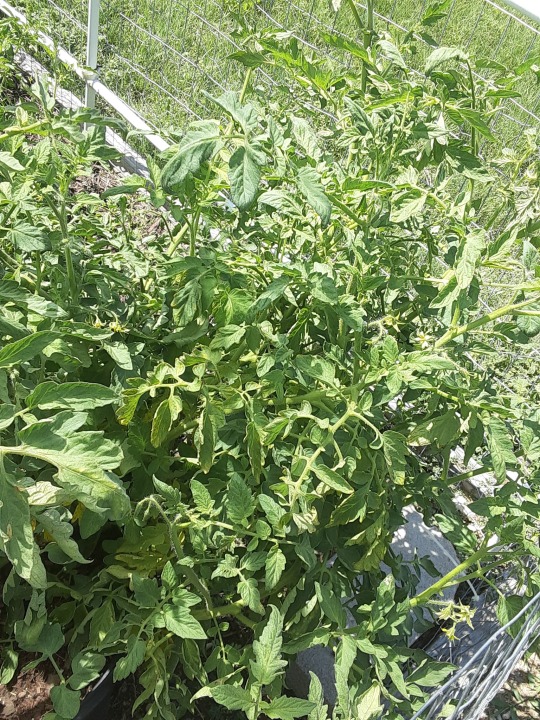
Next is the corn, which are also doing really well. It’s the sweet corn variety. Funny story, I planted the corn seeds without knowing you kind of need a lot to get a good crop because it’s wind pollinated. However, we have about 10 mature stalks and I’m hoping to get at least a small harvest. A few of the stalks are taller than me (5’3”/160cm) and one of the ears growing already has silk growing out of the ear.

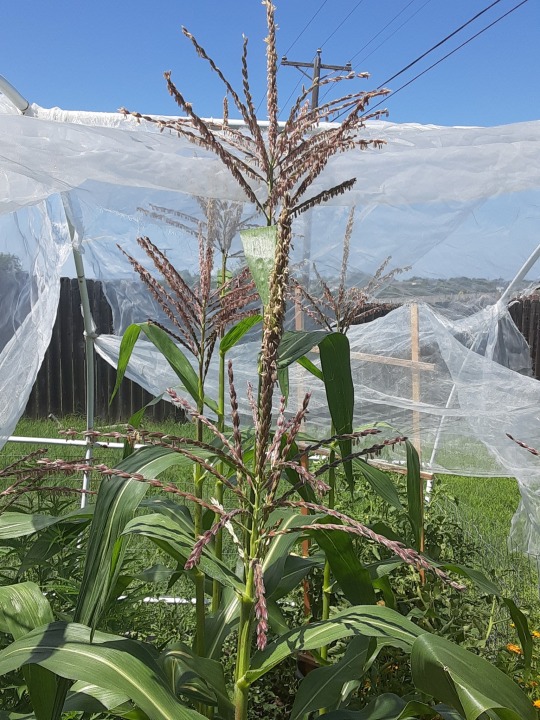

Next are the cucumbers. One of the plants has a few eggs on the bottoms of the leaves so I used some Sevin dust. I’m hesitant to use neem oil because I’ve noticed lots of ladybugs in the garden and don’t wanna kill them.




The carrots are doing well after being transplanted. Unfortunately I don’t remember when I started the seeds so I’m not sure if they should be farther along by now (I believe I planted around late April/early May—late for seeds I know but I’ve got a long growing season and few frosts).
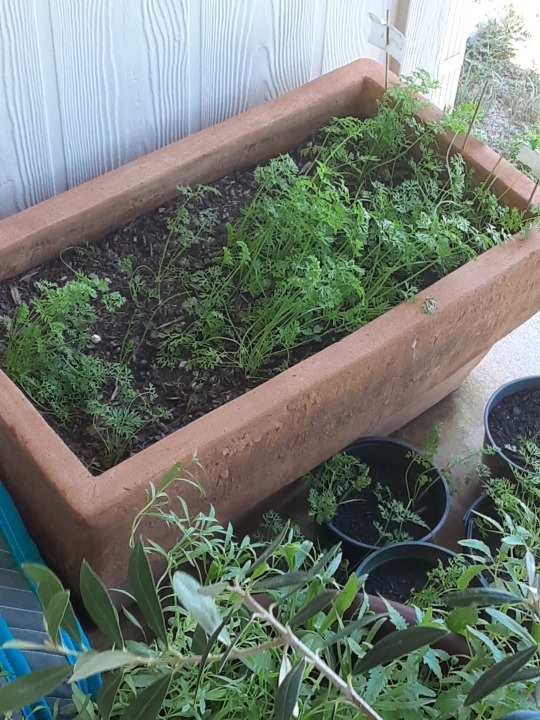
The various fruit trees/bushes/shrubs are doing well. Pictured are a thorny blackberry vine, an olive tree, a papaya tree, and a babcock peach tree. Everything is doing amazing. The blackberry is producing, the 4 peaches are growing and changing color while the olive, fig and papaya have been putting in some major growth/establishing.

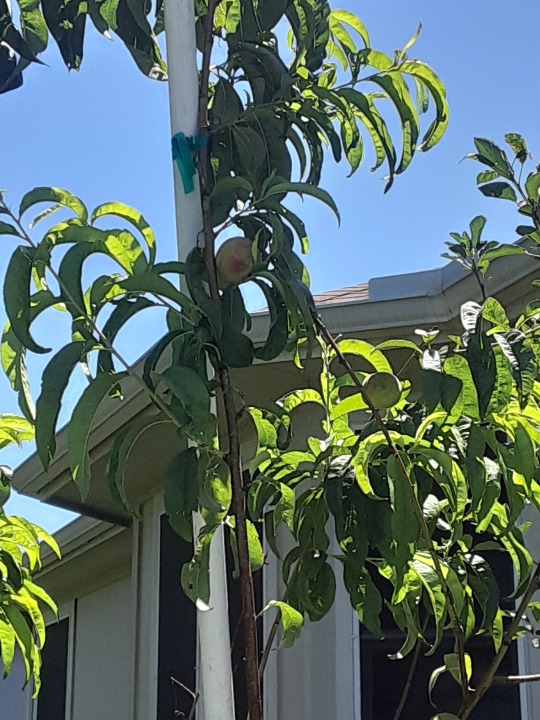



Last is the melon patch. It’s also exploded and there are so many watermelons throughout the whole patch of varying sizes from bb-sized to the one pictured with my hand. I didn’t see any cantaloupe yet, but there’s lots of flowers. I haven’t actually gone into the patch due to how crowded it is (I’m hoping if we do get some we’d be able to see them when they get big enough). I’m estimating we have between 12-15 watermelon at least so far.



However, not everything is doing so well. The rabbits have been so destructive, they killed my producing pole bean, the peppers I transplanted into the ground and most of the radishes, leaving 2 left for us (I did start new seeds though because radishes are some of the quickest vegetables you can grow from seed to harvest).

For things I didn’t cover like the grapes, blueberries, raspberries, guava trees, the apple tree, the lemon tree, various flowers, onions, potatoes, and pineapples, they are all doing good as well. I also wanna add that I did start new bush beans/pole beans as well as various kinds of peppers (jalapeños, hot salsa blend peppers, golden bell peppers) in containers to make up for the ones that got chewed. Hopefully those will make a nice fall harvest. The potatoes are almost ready to be harvested and the blueberries and raspberries have had berries ripen one at a time due to how small they are (this is the first year for berries).
As for other things I have planned, I have a few art pieces I’d like to post if that’s something y’all are interested in. I also would love to talk about my experience with gardening and mental health but any and all posts related to that will be labeled with appropriate trigger warnings.
Thanks for all the support with likes/reblogs. Feel free to come lurk, talk, vent, ask, whatever. I just wanna inspire others that think they cannot grow things that they can. If you’d like to talk I mostly would like to talk about gardening/plants/mental health and how it impacts us as humans.
Happy growing🌱🌿💙
#gardening#garden#garden update#gardencore#gardeningcore#melon patch#so proud of the watermelon#really everything because we did almost everything from seed this year#to save money and help with buying perennials like blueberries and fruit trees#instead of transplants that are like 5-10$#planting things from seed is so satisfying#like I turned a hard dry thing into a living thing that gives me food#vegetable garden#fruit garden
11 notes
·
View notes
Text
okey dokey!!! my little object (?) world is still in development but i really should share it with you all... (especially @mumpsetc so i'm tagging you!!) here's a little blurb on botanica!!!!
so this is a peaceful planet filled with sentient fruit! yay!! if you'd like to learn more, read below :D

in botanica, as fruit ripen on their plants, the plant material grows inside of the fruit, as if a miniature version of the plant has grown into it - botanican fruit possess a circulatory system of xylem and phloem within their flesh, with stems and vines growing out to form appendages (fig 1). all botanicans have leaves on at least one appendage, which they use to photosynthesize. aside from this energy from the sun, botanicans also drink water, which is taken in with a root tongue, and consume soil, from which nutrients and moisture are absorbed in a stomach-like organ. in doing so, botanicans effectively keep themselves "fresh" and/or "ripe", meaning that the life of a botanican fruit off of the parent plant is longer than that of a corresponding fruit in our world. all botanicans do eventually pass, and when they do, their bodies decompose and the seeds within them have the chance of growing into plants that will create more botanicans.
botanicans, like our fruit, come in different species, but those species are grouped into four categories: roaming botanicans, which are vine fruits (melons, tomatoes, squash, grapes), coasting botanicans, which are tropical fruits (bananas, papayas, pineapples, starfruit), floating botanicans, which are berries (raspberries, strawberries, blueberries, blackberries), and soaring botanicans, which are tree fruit (apples, pears, peaches, cherries). citrus fruits are in a subcategory between coasting and soaring botanicans. (all of these category names are subject to change though!!)
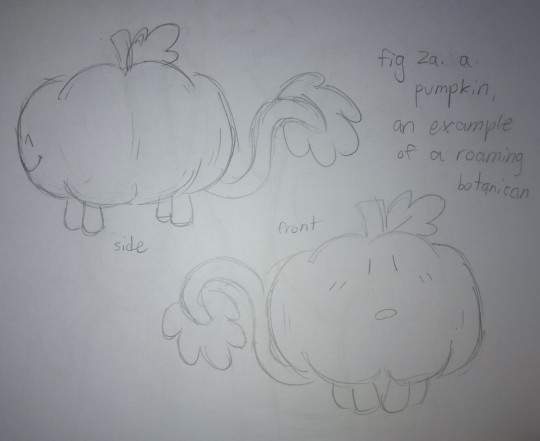
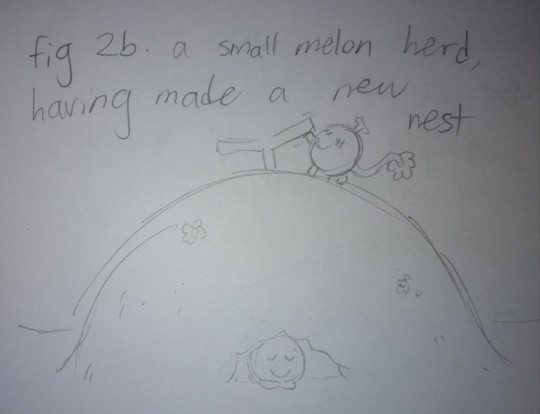
roaming botanicans are quadrupedal (four vine legs) with a prehensile vine-and-leaf tail (fig 2a); they live in sibling herds (usually small, but can vary in size) and roam around the landscape, without any designated leader among them. most roaming botanican species follow the sun year-round, and so avoid winter; in their constant migration they periodically stop to rest at hills, under which they burrow to make a nest. after making a nest under a hill, a herd will stick a branch at its peak so, after they leave, other herds will know that that hill can be used as a nesting site (fig 2b). some roaming botanicans have evolved to have particularly thick rinds, and so are more cold-resistant, and so opt not to constantly migrate, instead living more sedentary lives with occasional migration.
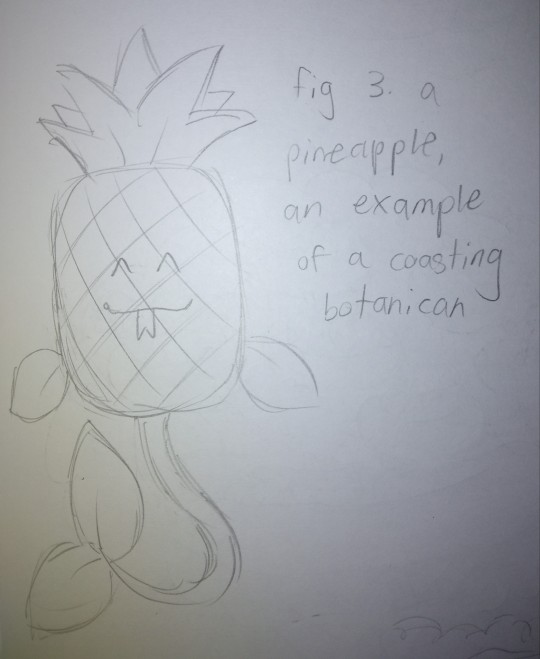
coasting botanicans have a stem-and-leaf tail and two leaf fins (fig 3); they grow on land but live the majority of their lives in the water, where they spend their time in groups. these groups are more based on friendship ties than familial ties, considering how vast a domain these botanicans have (basically the entire aquatic realm). more so than others, coasting botanicans connect with botanicans of other species and categories, and spend most of their lives just exploring and meeting others. while usually surrounded by others, a coasting botanican might on a rare chance find themselves alone in the ocean, in which case the loneliness will cause them to act in a way abnormal for most of their category - they will become antisocial and will lose their desire to explore. there are few cases of this occurring, however, given how populated and lively most corners of botanica's waters are.
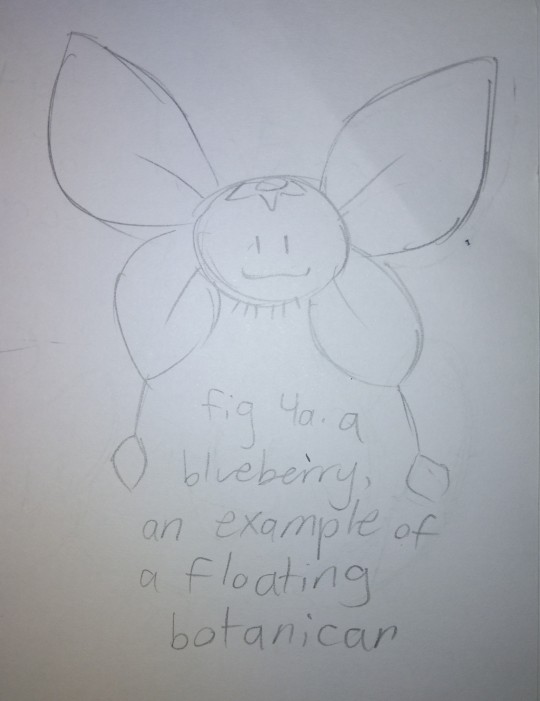
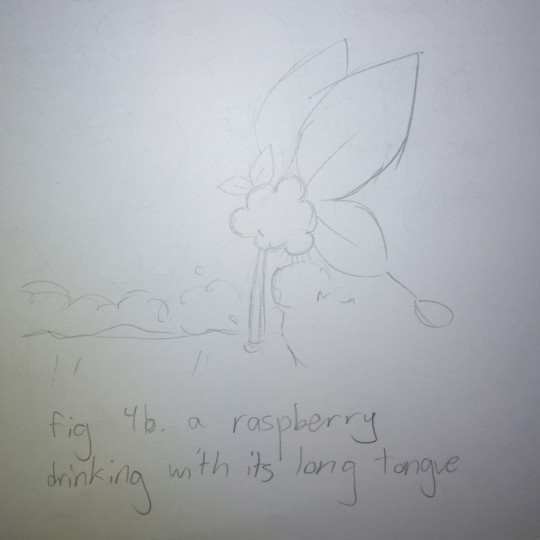
floating botanicans have four large leafy wings and six tiny stem feet (fig 4a); they are the most solitary of the four categories, being very individualized. they have a very strong connection to flowers, which they in fact pollinate - many cultivate their own gardens and end up specializing in a specific type of flower. floating botanicans can be very social at times, and often come together to form collaborative gardens and even breed flowers, but they do not live in groups. these botanicans, being so much smaller than the others, can often not safely drink out of rivers or lakes without falling in, and so have evolved a long root tongue to drink with (fig 4b).
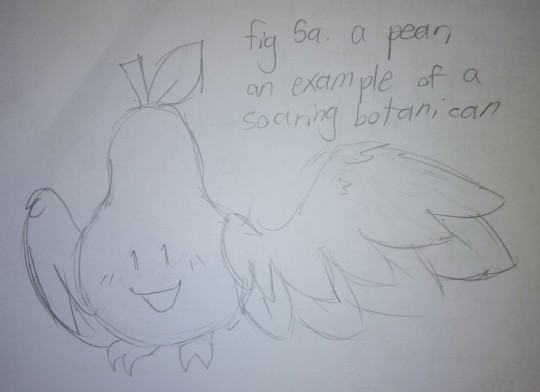
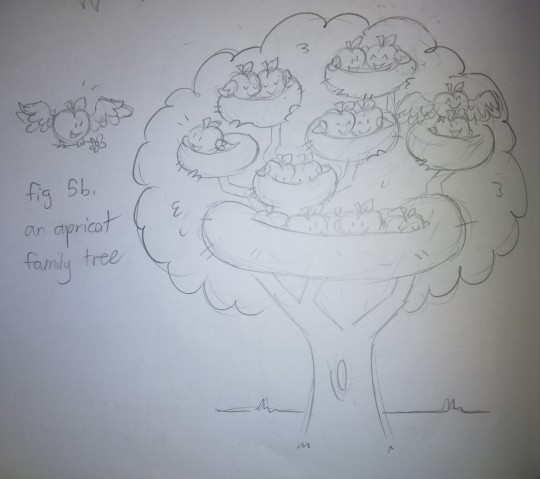
soaring botanicans have two large, leafy wings and two stem talons (fig 5a); they tend to live in very large familial flocks, as fruit trees often produce mass amounts of botanicans. the first to ripen is usually the leader of the flock. these botanicans build nests in their family tree (get it?) using fallen sticks, branches, and other plant materials, which becomes the center of life (fig 5b). within a flock of soaring botanicans, many individuals are designated to explore the surrounding area for interesting additions to the nests (such as a foreign flower or a pretty rock). due to the large size of these groups, most individuals within a flock form a "twin" bond with another individual, which they spend more time with than others.

i don't think i ever came up with a name for the soaring-coasting subcategory, but in any event, these botanicans have a single broad leaf tail and two stem talons (fig 6). these botanicans are more closely related to soaring botanicans than coasting botanicans, but as they tend to live in more watery areas, they have many similarities to coasting botanicans and do not have the capability of flight. botanicans of this category live in large flocks in ponds, lakes, and rivers; many build small dams. unlike those of the typical flock of soaring botanicans, individuals within flocks of these botanicans tend to intermix more; they often make friends between flocks and so there seems to be some kind of broad botanican network from pond to pond, river to river, lake to lake. these botanicans, like coasting botanicans, are very friendly and carefree.
botanica is a peaceful, happy planet; basically every resource needed for survival is in abundance and there is no opportunity for greed and selfishness to even arise, so individuals are more often than not cooperative, kind, and generous. of course, as loss and loneliness are truths of life, no botanican life is free of all suffering altogether, and issues can arise - but given the warm, compassionate nature of the surrounding physical and social environments, individuals end up living happy, loving lives overall.
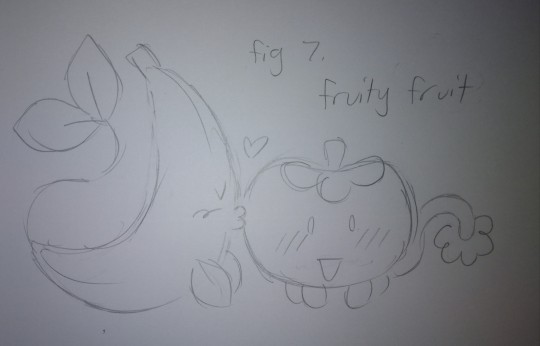
something interesting about botanican life is the complete disconnect between reproduction and relationhips - seeds are only spread after a botanican passes away, and those seeds grow into plants otherwise entirely disconnected from the botanican in question; then those plants are pollinated and new botanicans grow from them. in this way, botanicans have no real concept of sex, and often fall in love with and befriend members of different species (as there is no reason why this would be an issue; they wouldn't be reproducing with them anyway) (fig 7). while plant individuals sometimes have parts of a specific sex, most have parts of both sexes, and either way this has no impact on the mindset or behavior of the botanican as a whole creature (they technically have biological sex but they have no gender).
...so yeah, here's my silly fruit world!!! there's a lot of stuff left to talk about (with the gods of the world and everything) but this is good to start with :) i hope you like it!!!!
#dandy's doodles#botanica#osc#<- i never know if this really counts but i guess it does#this whole thing was very first created like 5 years before i even learned about the existence of object shows#but y'know there's a connection here#the reason why i love object shows so much is because i already personified inanimate objects!!#so yeah i guess this counts :)
46 notes
·
View notes
Note
Hi plant nerd anon from earlier! I handed off a couple of my plants to a friend because I just didn’t really vibe with them and I couldn’t just throw them away or let them die, and now I have space for a Sarracenia pitcher plant! Sarracenia differs from the family Nepenthes in just how the pitchers form: in Sarracenia, the entire leaf evolved to be the pitfall trap and it has generally larger cups that grow upwards from a rhizome; in Nepenthes, only the tendril (the structure that coils up and anchors grapes and beans to other objects) at the end of every leaf develops into a pitcher, and they grow upwards with a standard stem rather than a rhizome and have a more droopy kind of growth! They’re my fave carnivorous plants!!
I’ve also been collecting various native plants to turn into a costume for next year, it’ll be a sort of “woodland knight” kind of thing with scale mail made from seed pods from annual honesty plants (also called silver dollar plants!) and maybe magnolia leaves, but the cloak I have planned is going to be made up of dried flowers and fungi from throughout the entire year. It’s gonna be quite the undertaking, but it’s something I’m passionate about because I’m huge on conservation and education on native species of plants and fungi.
In addition I’ve also just watered my “baby toes” plant and she’s happy now that I’m watering her correctly, by taking her pot and putting it in a shallow dish of water to soak up until she’s had her fill. One of my favorite plants but she almost dried up, quite a scare!
I also need to put sand in with my false rose of Jericho, he’s been fine but I think some substrate to hold some water would be good for him.
Also processing some black walnuts I foraged about a month and a half ago, I’m aiming to make some spicy walnut fudge over the winter!
Thas all I really have energy for, have a wonderful night, knight!!! c:
This is what I made a Tumblr account for. I love to hear about stuff like this!
5 notes
·
View notes
Text
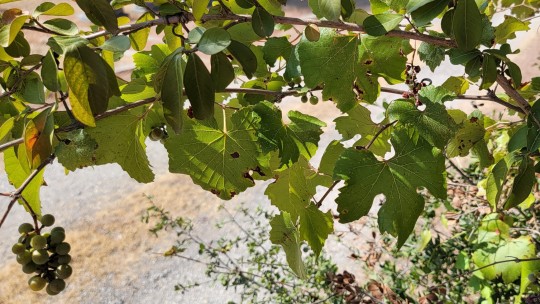
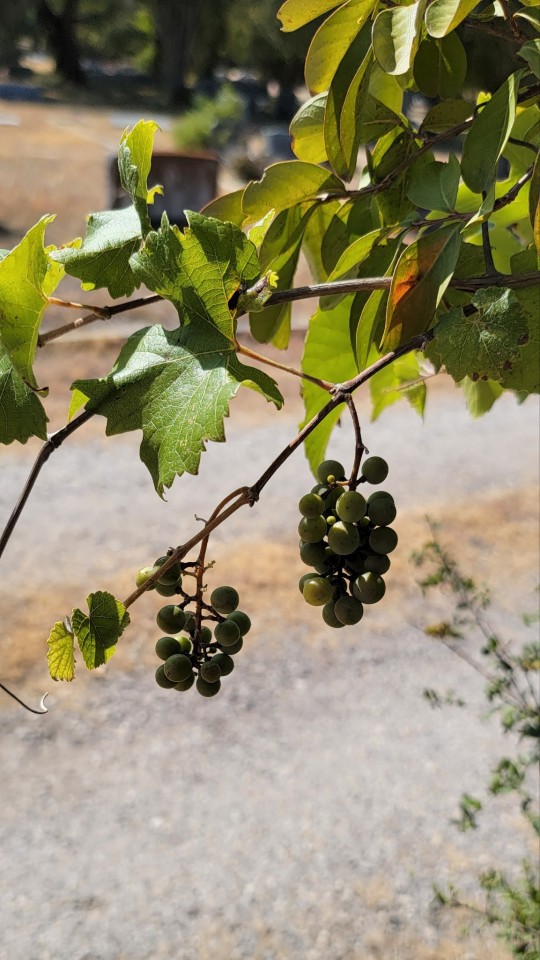

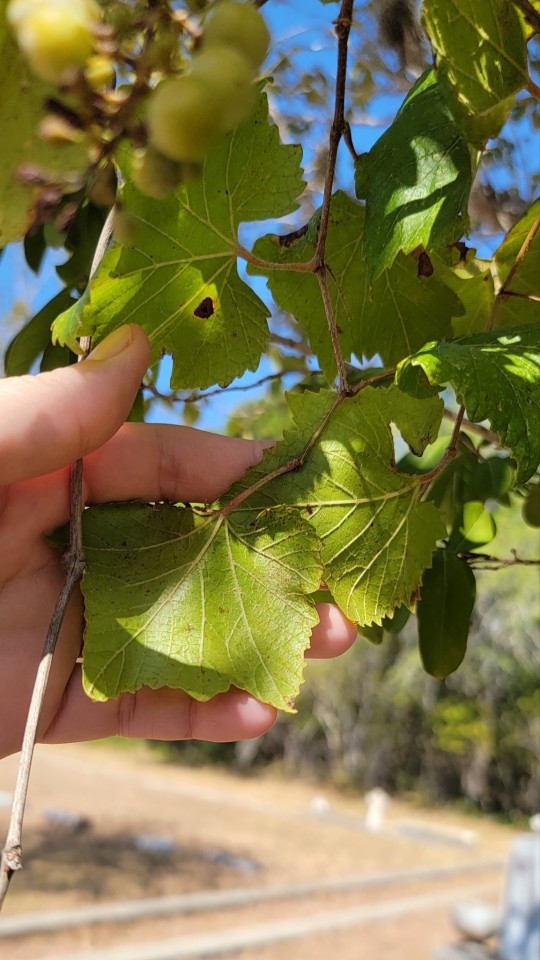

An unfamiliar grape I found at a cemetery. Mustang grapes (Vitis mustangensis) dominate this region, but they are very obviously different; larger in every way, with bigger clusters of fruit, and the backs of the leaves are white. The black grapes are also very tart and sting your mouth thanks to high quantities of oxalates. In contrast, the few edible-looking grapes on this vine were red and glaucous and quite mild and sweet, even though I don't think they were fully ripe. This offers us some constraints: extremely heat- and drought resistant, back of leaf not tomentose and same color as the front, smaller, palatable fruit, one large seed per fruit (collected three, 5-6mm long), grows on alkaline soil. There were other things I should have paid attention to, like the color of the bark and exact dimensions, and I should have collected a leaf for closer inspection of any small hairs, but I didn't.
I am very much not a Vitis expert, and admittedly haven't been paying much attention to them in general. There are a number of species in the area, including some Edwards Plateau endemics. The interesting thing about grapes, in contrast to the vast majority of plants, is that viticulture has neurotically picked over and assessed every North American species and natural hybrid for agricultural potential, no matter how obscure. You can find incredibly detailed charts for distinguishing one named cultivar from another. Theoretically this should make identification rather easy, but I'm still not certain. The five-lobed leaves suggest aestivalis, but the soil does not. Rotundifolia also excluded by alkalinity as well as the large size of its fruit. Berlandieri aka cinerea var. helleri seems like the most likely option, though I cannot find any indication it assumes a 5 lobed form. I suppose I can't eliminate Vitis monticola, but the same issue applies. It could be a hybrid with mustangensis, which does have an elaborately lobed form. It could be some manmade escapee. I'll go back at some point and take a better look.
19 notes
·
View notes
Text
Good News From Israel
In the 3rd Sep 23 edition of Israel’s good news, the highlights include:
Israeli bio-techs detect life-threatening diseases in DNA or cells.
Read news about six amazing Israeli medical device companies.
Jerusalem’s deputy mayor helps advance the career of women – in Morocco.
Israelis are busy in Africa, helping Rwanda, DRC, and Zambia.
Israeli innovation makes carbon-free ammonia fuel more likely.
The skies the limit for new Israeli planes and air routes.
Israeli sporting success in gymnastics, martial arts, athletics, and video games.
An Israeli woman certainly has someone watching over her.
Read More: Good News From Israel
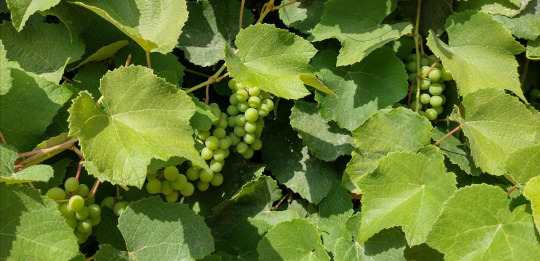
In many synagogues, last week's Torah portion described the joyful ceremony to be performed when bringing the first fruits of the season to the Temple in Jerusalem. So it is very appropriate to read how fruitful Israelis have recently been with innovative medical devices and new treatments. Israeli programs are bearing fruit to benefit the elderly in Spain, Ethiopian-Israeli immigrants, Arab fish farmers, Middle East businesswomen, New York Search & Rescue teams, America's Historically Black colleges and three African countries. We are seeing Israeli scientific breakthroughs come to fruition in producing sustainable fuels and recycling plastics. The high number of Israeli Unicorn (billion-dollar) companies shows how fruitful Israeli entrepreneurs have become, and the seeds for future successes are being planted with new investments into the hi-tech sector. I cannot explain, however, as to what has caused Israel to suddenly blossom at so many international sports. Finally, Israel's commitment to its children resulted in one Israeli girl overcoming cancer to become fruitful as a mother. The photo is of grapes growing on a wild vine adjacent to my local children's playground in Netanya.
#ammonia#Arabs#Artificial Intelligence#Black colleges#cancer#cruise#El Al#Ethiopians#Gal Gadot#good news#Israel#Jewish#medical devices#Morocco#Palestinians#recycling#shofar#Sodastream#ultrasound
14 notes
·
View notes